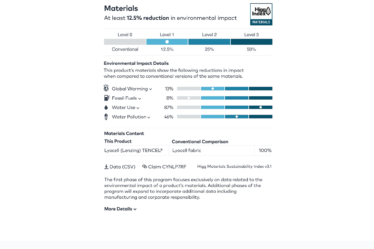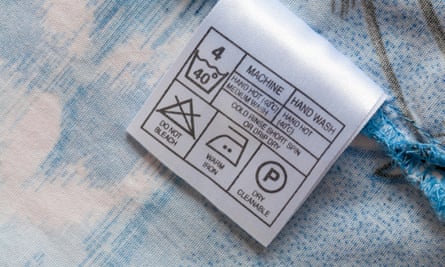
Bleach is an intimidating laundry product. It comes with the vague threat that it might ruin your clothes, it smells like a swimming pool and just generally feels like something that shouldn’t be poured into waterways. But it is a great tool for keeping white clothes white – a never-ending odyssey.
Like me, Zoe Mellick, a fashion lecturer at Queensland University of Technology, has always approached bleach with caution. “I have heard lots of horror stories about garments turning yellow or being eaten away,” she says. “I generally speak to my trusted dry-cleaner before using any bleach product at home, as they have a lot of knowledge about removing stains on different types of fabrics.”
But if you are game, here’s how to bleach at home.
Triangle of safety
Since not all materials are safe to bleach, the first step is to check the garment care label. The symbol for bleach is a solid triangle: an item that is safe to bleach will have one, a garment that should not be bleached will have one with a cross through the triangle.
The care label will also tell you whether the garment has to be machine or handwashed and the temperature at which an item can be safely washed. For best results use the highest temperature available.
What not to bleach
If you try to bleach animal fibres like wool, silk, cashmere or leather, you risk ruining the garment. Similarly, elastane and spandex will be damaged by bleach, says Rebecca Van Amber, a textile scientist at RMIT University. “Only natural cellulose fibres or synthetic fibres can be bleached.”
Fabrics that are safe to bleach include cotton, viscose rayon, linen, hemp, polyester and nylon.
Unless you are confidently chasing a tie-dye look, Van Amber suggests never using bleach to change a garment’s colour. “[It] can be quite unpredictable and may result in a patchy look.”
“It’s a good idea to avoid using bleach on clothes that have decorative prints or details,” says Mellick. “Bleach can cause these to fade or become damaged.”
Which bleach is best?
“Generally speaking, there are two types of bleach: a chlorine bleach and non-chlorine bleach, [which is also called] oxygen bleach,” says Mellick. The latter is much gentler on garments.
Be sure to check the label on the bottle, as the wrong bleach can damage materials and not all bleach is safe to use on fabric. If you’re unsure, Mellick suggests consulting your dry-cleaner.
“I spoke to a dry-cleaner [about refreshing a white polyester and silk skirt] to see what could be done and they suggested using oxygen bleach because chlorine bleach would cause the polyester to go yellow,” she says. “I soaked the skirt multiple times in oxygen bleach and the staining slowly came out – but it was a labour of love.”
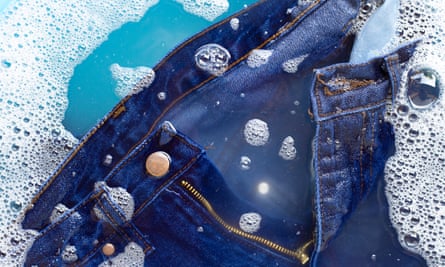
To test whether a coloured garment is colourfast, rub a wet, white cloth against the garment to see if it picks up any colour – a colourfast garment won’t stain the cloth.
Brightening whites
“Bleach can be used to brighten old fabrics that have yellowed or become dingy over time,” Mellick says. “Always follow the instructions on the [bleach bottle], which generally include diluting the bleach with water and soaking the fabric for a short period, then rinsing thoroughly.”
Van Amber says to dilute bleach, the ratio should generally be about 15 to 20 millilitres of bleach to one litre of water, but this might vary depending on how you are using it.
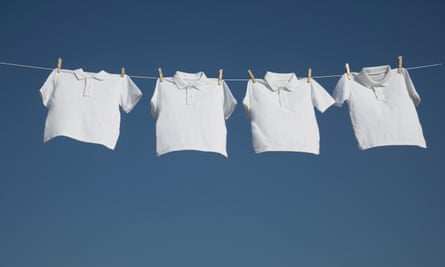
Bleach can also be added directly to your washing machine. Depending on the severity of the stain, add between one-third or two-thirds of a cup of bleach to the machine’s bleach dispenser. If you’re using a top loader washing machine, pour the diluted bleach directly into the load about five minutes into the cycle.
If you are bleaching a particularly precious garment, it might be worth doing a test on a small inconspicuous area of the garment to see what happens before proceeding.
What about spot-cleaning?
If a garment has been stained, bleach can help. “Depending on the type of stain, you could gently spot-clean the area with a small amount of bleach,” Van Amber says. She’s done so successfully herself: “I recently used a Q-tip soaked in a diluted bleach solution … I then rinsed the area thoroughly.”
For yellow sweat stains, Mellick suggests using oxygen bleach in powder form. You can buy this at the supermarket. Make a paste out of it with a little bit of water. This can be spread over the affected areas of a garment, then scrubbed with a brush. Next, wash the garment in the washing machine with laundry detergent and repeat the process if necessary.
Take precautions
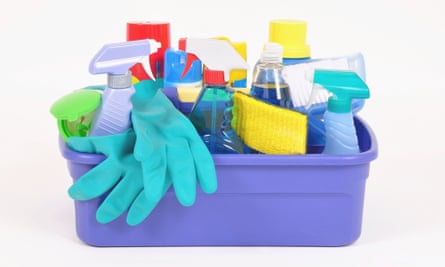
Since bleach can be harmful to bare skin or when inhaled, Van Amber suggests to always wear gloves and protective glasses, and work in a well-ventilated area when using it.
“Bleach is considered harmful to the environment, particularly waterways and aquatic life, so the best advice is to minimise and reduce the use of bleach wherever possible.”
If you have sensitive skin or allergies, Mellick says it’s best to avoid using bleach altogether.

